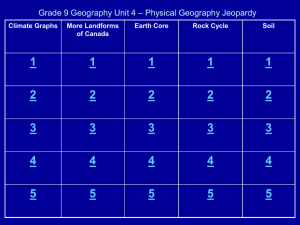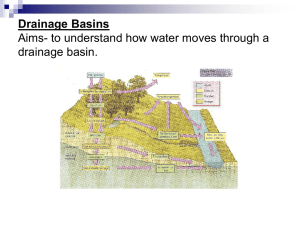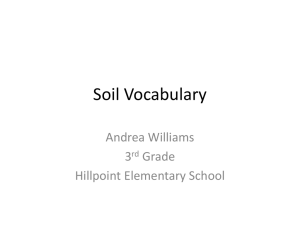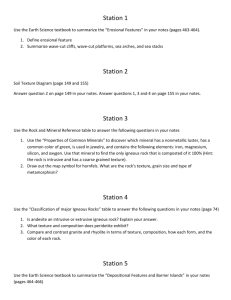Chapter 6, webnotes
advertisement
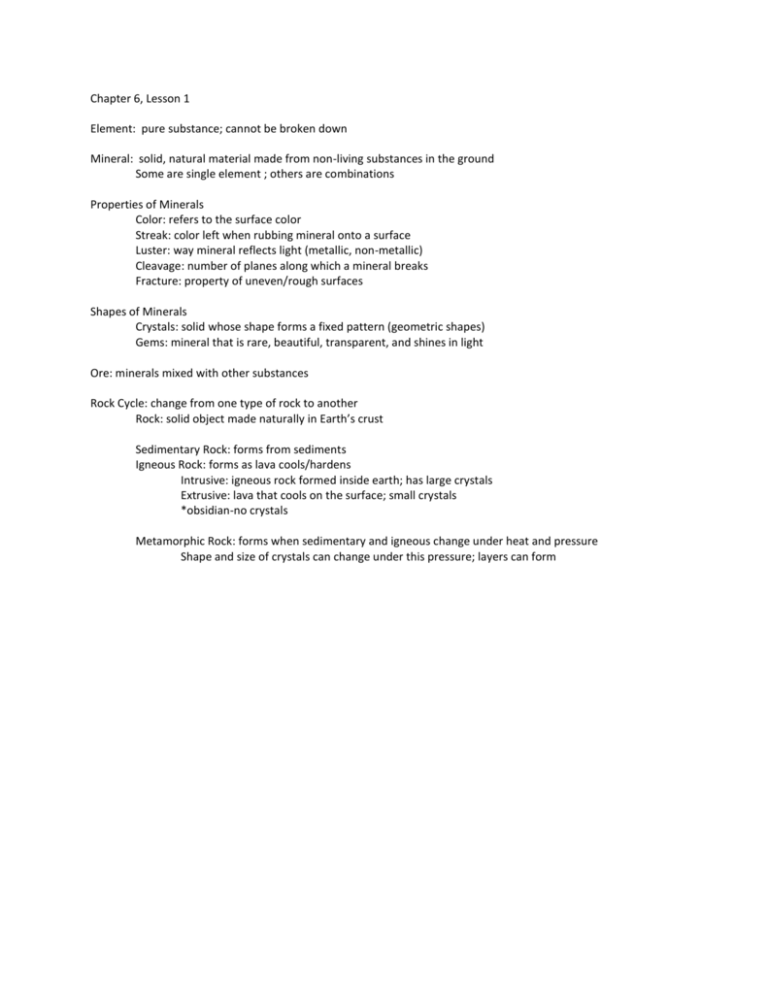
Chapter 6, Lesson 1 Element: pure substance; cannot be broken down Mineral: solid, natural material made from non-living substances in the ground Some are single element ; others are combinations Properties of Minerals Color: refers to the surface color Streak: color left when rubbing mineral onto a surface Luster: way mineral reflects light (metallic, non-metallic) Cleavage: number of planes along which a mineral breaks Fracture: property of uneven/rough surfaces Shapes of Minerals Crystals: solid whose shape forms a fixed pattern (geometric shapes) Gems: mineral that is rare, beautiful, transparent, and shines in light Ore: minerals mixed with other substances Rock Cycle: change from one type of rock to another Rock: solid object made naturally in Earth’s crust Sedimentary Rock: forms from sediments Igneous Rock: forms as lava cools/hardens Intrusive: igneous rock formed inside earth; has large crystals Extrusive: lava that cools on the surface; small crystals *obsidian-no crystals Metamorphic Rock: forms when sedimentary and igneous change under heat and pressure Shape and size of crystals can change under this pressure; layers can form Chapter 6, Lesson 2 Organic: having to do with or coming from living things Soil: mixture of rock and once living parts of plants and animals; formation starts with weathering of rocks Soil Horizon: layer of soil A Horizon – topsoil; most plants grow here Humus: made of decayed organic material; feeds plants, soaks up and holds water B Horizon – subsoil Less humus; fine rocks; clay C Horizon – larger pieces of weathered rock resting on bedrock Forest Soil: thin layer of topsoil; little humus Desert Soil: not much humus Grassland & Prairie Soil: rich in humus; good for farming Pollution: harmful materials added to soil, air, and water Conservation: the protection of natural resources, including soil Fertilization: replace lost nutrients Crop Rotation: change crops yearly Strip Farming: grass between crops Contour Plowing: curves on hills Terracing: levels on hills Wind Breaks: trees on edge Chapter 6, Lesson 3 Fossils: the remains of ancient organisms preserved in soil or rock; found in sedimentary rock Fossil Fuels: formed from the decay of ancient organisms and used today for energy Bituminous coal: soft coal Anthracite: hard coal Oil and natural gas are formed from decayed ocean organisms under heat, weight, and bacteria Law of Superposition: each layer of rock is younger than the one below it Fossil age determined by age of rock Relative Age: age compared to another rock Absolute Age: age in years Alternative Energy Source: any source other than fossil fuel Wind: windmills generate electricity Water: hydroelectricity Solar: from the sun; inexhaustible Geothermal: from deep inside earth Nuclear: changes in atoms Chapter 6, Lesson 4 97% of water is salt water Saltwater is made when rain runs downhill and picks up salts from soil and rock Running Water: streams and rivers Standing water: lakes and reservoirs Groundwater: beneath the surface Aquifer: underground layer of rock or soil that absorbs water Water Treatment Coagulation: attract dirt Sedimentation: dirt falls to bottom Filtration: remove remaining bits Disinfection: chlorine added Smog: yellow haze produced when fossil fuels are burned Ozone: a form of oxygen that protects living things from radiation





